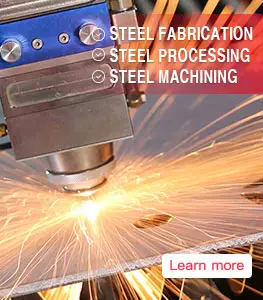Welcome to BBN Steel Materials Factory
What is the difference between SA36 and A36 steel?

SA36 and A36 carbon steel are two commonly used carbon steel grades by the American Society of Mechanical Engineers (ASME) and the American Society for Testing and Materials (ASTM) respectively. While they share some similarities in composition and strength, there are subtle differences that make them distinct from each other.
SA36 carbon steel is a designation for a low carbon structural steel with a yield strength of 36,000 psi, while A36 is a designation for a low carbon structural steel with a yield strength of 36,000 psi. Both SA36 and A36 are carbon steel grades with good strength and ductility, making them suitable for a wide range of applications in various industries. However, the chemical composition and mechanical properties of the two grades differ slightly.
The chemical composition of SA36 and A36 steel grades are controlled by the ASME and ASTM standards, which prescribe the maximum allowable amounts of various elements. Both grades of steel are predominantly composed of iron, but there are some differences in the chemical composition of the alloys.
ASME SA36 Carbon and Low-alloy Steel contains a maximum of 0.26% carbon, 0.40% silicon, and 0.20% copper. A36 carbon steel contains a maximum of 0.29% carbon, 0.25% phosphorus, and 0.20% sulfur. Both SA36 and A36 steel grades have trace amounts of other elements such as manganese, phosphorus, and sulfur. the main difference between SA36 and A36 steel grades is the presence of trace amounts of elements such as nickel, chromium, and molybdenum in A36 steel, which are absent from SA36 steel. These elements give A36 steel a slightly higher yield and tensile strength, making it suitable for applications that require higher strength.
| ASTM A36/SA36 Steel Coil Sheet Plate Chemical Composition | |||||
|---|---|---|---|---|---|
| Thickness | ≤20mm | 20-40mm | 40-65mm | 65-100mm | >100mm |
| Carbon | 0.25 | 0.25 | 0.26 | 0.27 | 0.29 |
| Manganese | - | 0.80-1.20 | 0.80-1.20 | 0.85-1.20 | 0.85-1.20 |
| Phosphorus | 0.04 | 0.04 | 0.04 | 0.04 | 0.04 |
| Sulfur | 0.05 | 0.05 | 0.05 | 0.05 | 0.05 |
| Silicon | 0.40 | 0.40 | 0.15-0.40 | 0.15-0.40 | 0.15-0.40 |
| Copper min. | 0.20 | 0.20 | 0.20 | 0.20 | 0.20 |
Both SA36 and A36 steel grades have a yield strength of 36,000 psi and a tensile strength of 58,000-80,000 psi. This means that they have similar strength levels and can be used interchangeably in many applications. They both have good ductility and toughness, which makes them versatile and suitable for a variety of applications. However, the presence of trace amounts of elements such as nickel, chromium, and molybdenum in A36 steel gives it slightly higher strength and hardness than SA36 steel. This makes A36 steel better suited for applications that require higher strength and structural integrity, such as building construction, bridges, and heavy machinery.
SA36 and A36 steel grades are easy to weld using various welding methods such as shielded metal arc welding (SMAW), gas tungsten arc welding (GTAW), and gas metal arc welding (GMAW). They have good weldability and can be welded using conventional welding techniques without experiencing any significant distortion, cracking, or other problems. But it is important to note that A36 steel is more prone to a phenomenon known as strain age embrittlement, which can occur during welding. This can lead to the development of cracks and fissures in the welded area, reducing the strength and structural integrity of the material. To prevent this, A36 steel should be preheated before welding and welded at lower temperatures than SA36 steel.
ASME SA36 Carbon Steel and ASTM A36 Carbon and Low-alloy Steel grades are widely used in many industrial and commercial applications, including building construction, automotive manufacturing, oil and gas industry, and heavy machinery. Both grades of steel are used in the construction of bridges, buildings, and other structures that require high strength and durability. SA36 steel is commonly used in the construction of pressure vessels and boilers, while A36 steel is often used in the construction of bridges and buildings. A36 steel is also used in the manufacturing of truck frames, agricultural machinery, and automotive parts.
.webp)
.webp)
.webp)
.webp)
.webp)
.webp)
.webp)
.webp)
.webp)



Leave a Message